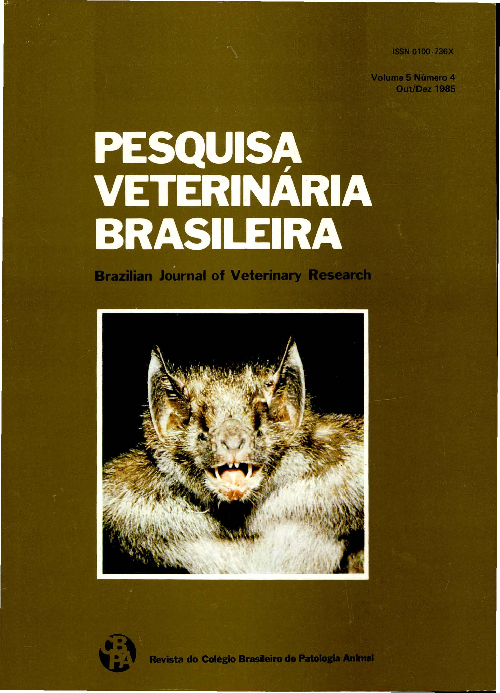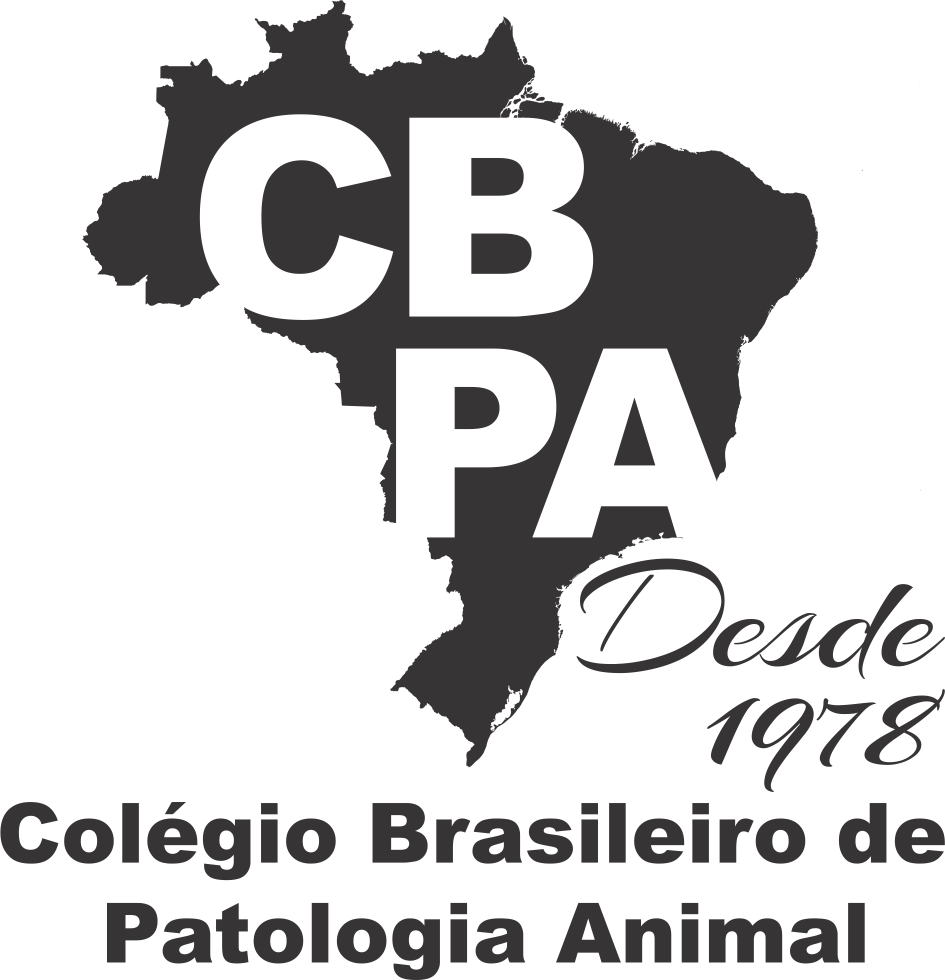

Livestock Diseases
Behavioral study of the vampire bat Desmodus rotundus (Chiroptera) related with the attack rate on cattle in captivity
- Abstracts: English Portuguese
Abstract in English:
The objective of this study was to determine the attack rate of vampire bats, Desmodus rotundus (Geoffroy, 1810), on cattle kept in captivity. It was observed that the bats returned to wounds previously made by them, but without a rigorous pattern of repetition. New wounds were made almost everyday, while old wounds were temporarily or definitively abandoned. Vampire bats fed on all regions of the body, although showed preference for the front legs, dorsal region, hind legs and withers. Finally, a great number of wounds were opened, whereas only a few were utilized on the sarne night.
Abstract in Portuguese:
O objetivo deste estudo foi determinar a taxa de ataque de morcegos hematófagos Desmodus rotundus alimentando-se em bovinos mantidos em cativeiro. Observou-se que os morcegos retornam aos ferimentos por eles provocados anteriormente, porém sem um padrão rigoroso de repetitividade. Eles abrem novos ferimentos quase que diariamente e abandonam temporária ou definitivamente outros. Os morcegos sugaram em todas as regiões corporais dos bovinos, mas preferencialmente nos membros anteriores, dorso, membros posteriores e cernelha. Finalmente, causam um grande número de ferimentos nos animais, apesar de utilizarem poucos deles por dia.
Importance of Corynebacterium bovis in bovine mastitis aetiology in the State of São Paulo, Brazil
- Abstracts: English Portuguese
Abstract in English:
Data on the isolation of Corynebacterium bovis from a study realized in dairy herds from 17 municipalities in the Sta te of São Paulo, Brazil, are presented and discussed. The rnicrotsrganism was isolated from 954 (32.5%) of the 2935 samples examined. The percentage of isolation in the different municipalities varied from 0.0 to 73.6. Pure cultures were obtained from 28.2% of the quarters showing clinical mastitis and from 27.5% of those with sub-clinical mastitis as detected by the Califomia Mastitis Test (CMT) and modified Whiteside test. In addition to pure cultures, C. bovis was isolated together with Staphylococcus sp., Streptococcus sp., Pseudomonas sp., Enterobacteriaceae, Actinomycetales and others from 58.3% ofthe samples, predominantely fr_om quarters with mastitis. In outbreaks of C. bovis in three dairy herds, the microtsrganism was isolated from more than 70% of the samples, 78.8% of the isolations corning from quarters with clinical or sub-clinical mastitis.
Abstract in Portuguese:
São apresentados e discutidos dados sobre o isolamento de Corynebacterium bovis no estudo realizado em propriedades de exploração leiteira, de 17 municípios do Estado de São Paulo, Brasil. Este microrganismo foi isolado de 954 das 2935 amostras examinadas (32,50%). A porcentagem de isolamento variou de 0,00% a 73,57% nos diferentes municípios. Foi obtido em cultura pura em 28,18% de quartos com mastite clínica e 27 ,45% daqueles com mastite sub-clínica (detectados pelas provas de CMT e Whiteside modificado). Além dos isolamentos em cultura pura, foi encontrado associado a outros microrganismos, como Staphylococcus sp., Streptococcus sp., Pseudomonas sp., Enterobacteriaceae, Actinomicetales e outros, em 58,27% das amostras, predominantemente de quartos com mastite. No presente trabalho são também relatados surtos por Corynebacterium bovis em três propriedades. Nestes surtos esse microrganismo foi isolado em mais de 70,00% das amostras, correspondendo 78,75% desses isolamentos a quartos com processos de mastite clínica e sub-clínica.
Experimental poisoning of rabbits by Mascagnia aff. rigida (Malphighiaceae)
- Abstracts: English Portuguese
Abstract in English:
The dried and powdered leaves of Mascagniaaff. rigida (Juss.) Griseb., a plant toxic forcattle, were administered by stomach tube to 31 raobits, in doses which varied from 0.25 to 2.5 g/kg of body weight. Fourteen rabbits died. The lethal dose was quite constant; 2 g/kg killed all rabbits, 1 g/kg killed anywhere from none to all of the rabbits depending on when and where the plant was collected, 0.5 g/kg caused the death of only one rabbit. First symtoms were seen from 2h 45min. to 10h 30min. after ingestion of the plant. The course of the poisoning lasted from 1 to 4 minutes. The symptoms were those of "sudden death": the rabbit suddenly made violent uncontrolled movements, struggled or jumped, and then generally fell on its side. Respiration became difficult, intermittent and the animal died. From the beginning of symptoms until death half of the rabbits emitted screams. The post-mortem findings consisted only in slight lesions in the liver. Histopathological changes of degenerative-necrotic and vascular nature were found in the liver, as well as degenera tive lesions in the kidney and heart. In the liver there was necrosis, vacuolization and albuminous-granular degeneration, congestion, dissociation, and compressive atrophy of the liver cords, presence of eosinophilic sphaerules in the sinusoids and edema of Disse's space. The kidney showed hydropic-vacuolar degeneration of the epitelial cells of the distal convoluted tubules, swelling of the epithelial cells of the convoluted tu bules of the cortico-medular junction and fatty changes in various locations. Intracellular edema and dissociation of the muscle fibers, along with foci of increased eosinophilia were found in the heart.
Abstract in Portuguese:
As folhas dessecadas e pulverizadas de Mascagnia aff. rigida (Juss.) Griseb., planta tóxica para bovinos, foram administradas por via intragástrica a 31 coelhos, em quantidades que variaram de 0,25 a 2,5 g da planta por kg de peso vivo. Morreram 14 coelhos. A dose letal foi bastante constante; 2g/kg causaram a morte de todos os coelhos, enquanto que 1g/kg causou a morte de nenhum ou de todos os coelhos, dependendo da época da coleta e da procedência da planta; dos que receberam a dose de 0,5 g/kg apenas um coelho morreu. O início dos sintomas de intoxicação ocorreu de 2h 45min. a 10h 30min. após a administração da planta. A evolução da intoxicação durou de 1 a 4 minutos. Os sintomas de intoxicação foram os da síndrome de "morte súbita": o coelho fazia repentinamente movimentos desordenados violentos, debatia-se ou pulava, e em seguida geralmente caía de lado. A respiração tornava-se difícil, espaçada e o animal morria. Desde o início do aparecimento dos sintomas até à morte, cerca de metade dos coelhos emitiam gritos com maior ou menor freqüência. Os achados de necropsia se limitaram a leves alterações do fígado. Os exames histopatológicos revelaram alterações degenerativo-necróticas e vasculares no fígado, e degenerativas no rim e coração. No fígado foram observados necrose, vacuolização citoplasmática (em parte dos casos positivo para gordura) e degeneração albuminosa-granular dos hepatócitos, congestão, dissociação dos cordões hepáticos, atrofia compressiva desses, presença de esférulas eosinofílicas nos sinusóides e edema dos espaços de Disse; no rim, degeneração hidrópico-vacuolar das células epiteliais dos túbulos contornados distais, tumefação das células epiteliais dos túbulos contornados na junção córtico-medular e esteatose de variável localização; no coração, edema intracelular das fibras cardíacas, afastamento entre estas e presença de focos de eosinofilia aumentada no músculo cardíaco.
Seroepidemiological survey of transmissible gastroenteritis virus in reproductive swine herds in the State of Santa Catarina
- Abstracts: English Portuguese
Abstract in English:
A seroepidemiological suivey utilizitig the micro serum neutralization test for the detection of antibodies to transmissible gastroenteritis (TGE) virus was carried out on 5859 swine sera obtained from 59 of the 70 reproductive herds, registered with the Swine Breeding Association of Santa Catarina, distributed in 24 counties within the state. When tested undiluted and in the 1 :2 and 1 :4 dilutions, none of the 403 sera obtained from boars contained antibody, while of the 5451 sow sera tested, 5444 were devoid of antibody, five were toxic for the indicator cells and two had a neutralizing activity up to the 1 :2 dilution. Testing of a second sample obtained from these two pigs revealed that they were free of antibody. The results of this suivey indica te that the reproductive swine herds of the State of Santa Catarina tested in the present study are free of infection with TGE virus.
Abstract in Portuguese:
Foi realizado um inquérito soro-epidemiológico utilizando o microteste de soroneutralização para a detecção de anticorpos para o vírus da gastroenterite transmissível (TGE) em 5859 soros suínos obtidos de 59 dos 70 plantéis de reprodutores registrados na Associação Catarinense de Criadores de Suínos (ACCS), distribuídos em 24 municípios do Estado de Santa Catarina. Quando testados não diluídos e nas diluições de 1 :2 e 1 :4, nenhum dos 403 soros obtidos de cachaços continham anticorpos, enquanto que, dos 5451 soros de porcas testados, 5444 estavam isentos de anticorpos, cinco foram tóxicos para as células indicadoras e apenas dois possuíam uma atividade neutralizante até a diluição de 1 :2. A testagem de uma segunda amostra destes dois suínos revelou que eram livres de anticorpos. Os resultados do inquérito indicam que os plantéis de reprodutores suínos do Estado de Santa Catarina testados no presente estudo, encontram-se livres da infecção com o vírus da TGE.
Intoxication by Solanum fastigiatum var. fastigiatum: evolution and reversibility of the lesions in cattle and susceptibility of sheep, rabbits, guinea pigs and rats
- Abstracts: English Portuguese
Abstract in English:
The evolution of lesions caused by Solanum fastigiatum var. fastigiatum in the central nervous system of cattle was studied experimentally in 7 calves. The doses used varied from 75 to 1,163 g/kg of body weight, administered in periods from 15 to 620 days. Initial alterations were characterized by vacuolation of Purkinje cells and the presence of axonal spheroids in the cerebellar granular layer. Later there was a loss of Purkinje cells which were replaced by astroglia. Axonal spheroids suffered wallerian degeneration and, as a consequence microcavitation and proliferation of astroglia were observed. Simultaneously with the degenerative process, perivascular cuffing, consisting mainly of macrophages, was observed. The reversibility of the lesions was studied in four calves, two of which received 440 g/kg of body weight while the other two received 350 g/kg. One of the animals which received 440 g/kg during 140 days and another which received 350 g/kg during 107 days were slaughtered at the end of plant administration. The remaining two animals were maintained without the plant for an additional 113 and 63 days, respectively, and then slaughtered. This study showed that lesions in the pericaryon and axons of Purkinje cells, are slowly reversible, and that some spheroids probably originating from the lost Purkinje cells, suffer wallerian degeneration. The lesions observed, as well as their evolution, are similar to those described in storage diseases. The fact that these alterations are slowly reversible points to the possibility thant the disease occurs as a consequence of an enzymatic inhibition or from the presence of a slowly hydrolyzed substance in the plant. In order to study the susceptibility to the intoxication by Solanum fastigiatum var. fastigiatum, three sheep were fed 430 g/kg of body weight in a period of 202 to 370 days, while six rabbits, six guinea pigs and eight rats received 10% of the plant in a commercial feed during 120 days. Of all species tested, only sheep were susceptible to the intoxication showing lesions similar to those observed in calves.
Abstract in Portuguese:
Foi estudada a evolução das lesões do sistema nervoso central causadas por Solanum fastigiatum var. fastigiatum em 7 bovinos. Utilizaram-se doses que variaram de 75 g/kg de peso a l.163 g/kg de peso administradas num período entre 15 e 620 dias. As alterações iniciais caracterizaram-se por vacuolização das células de Purkinje e presença de esferóides axonais localizados na substância branca cerebelar. Posteriormente, ocorreu o desaparecimento de células de Purkinje, sendo substituídas por astroglia. Os esferóides axonais sofreram degeneração walleriana, observando-se, em conseqüência, microcavitações e proliferação de astroglia. Simultaneamente ao processo degenerativo, observou-se acúmulo perivascular constituído principalmente por macrófagos. A reversibilidade das lesões foi estudada em 4 bovinos, dois dos quais receberam 440 g/kg de peso, os outros dois, 350 g/kg de peso. Um dos bovinos que receberam 440 g/kg de peso durante 140 dias e outro que recebeu 350 g/kg durante 107 dias, foram sacrificados após o final da administração da planta, e os outros dois animais foram mantidos sem a planta por 113 e 63 dias, respectivamente, e, posteriormente, sacrificados. Este estudo demonstrou que as lesões do pericário e axônios são lentamente reversíveis, e alguns esferóides, pertencentes provavelmente às células de Purkinje já desaparecidas, sofrem degeneração walleriana. As lesões observadas, bem como sua evolução são similares às descritas nas doenças do armazenamento; o fato de que essas alterações sejam lentamente reversíveis indica a possibilidade de que a enfermidade ocorra em conseqüência de uma inibição enzimática ou da presença de uma substância lentamente hidrolisável contida na planta. Para o estudo da suscetibilidade à intoxicação por Solanum fastigiatum var. fastigiatum, foram utilizados 3 ovinos que receberam 430 g/kg de peso, num período de 202 a 370 dias, e 6 coelhos, 6 cobaias e 8 ratos, que receberam planta a 10% misturada em ração comercial durante 120 dias. Das espécies utilizadas, somente os ovinos foram sensíveis à intoxicação por esta planta, mostrando lesões similares às observadas em bovinos.
Production of bacteriocins by Salmonella isolated from chickens and turkeys
- Abstracts: English Portuguese
Abstract in English:
Production of bacteriocins was investigated in 24 strains of Salmonella isolated from two flocks of birds: one of breeder turkeys and another of breeder chickens, both apparently healthy. Eleven strains of S. typhimurium, two of S. saintpaul, two of S. eimsbuettel and nine of S. arizonae were used in this experiment. All strains but S. arizonae produced bacteriocins. As far as bacteriocinogenicity was concerned, the strains tested apparently belonged to two groups.
Abstract in Portuguese:
Investigou-se a produção de bacteriocinas de 24 amostras de salmonela isoladas de dois lotes de aves: um de perus e outro de galinhas reprodutoras, aparentemente normais. Foram testadas onze amostras de Salmonella typhimurium, duas de S. saintpaul, duas amostras de S. eimsbuettel e nove S. arizonae. Todas as amostras, com exceção de S. arizonae, produziram bacteriocinas. Neste estudo, houve formação de dois grupos do ponto de vista de bacteriocinogenicidade.








